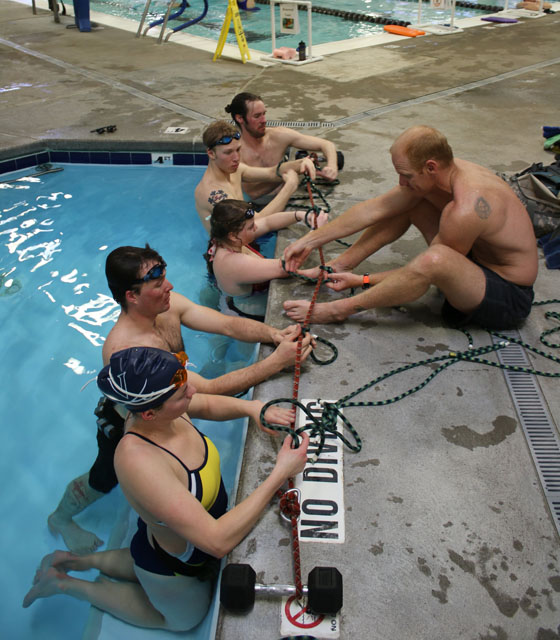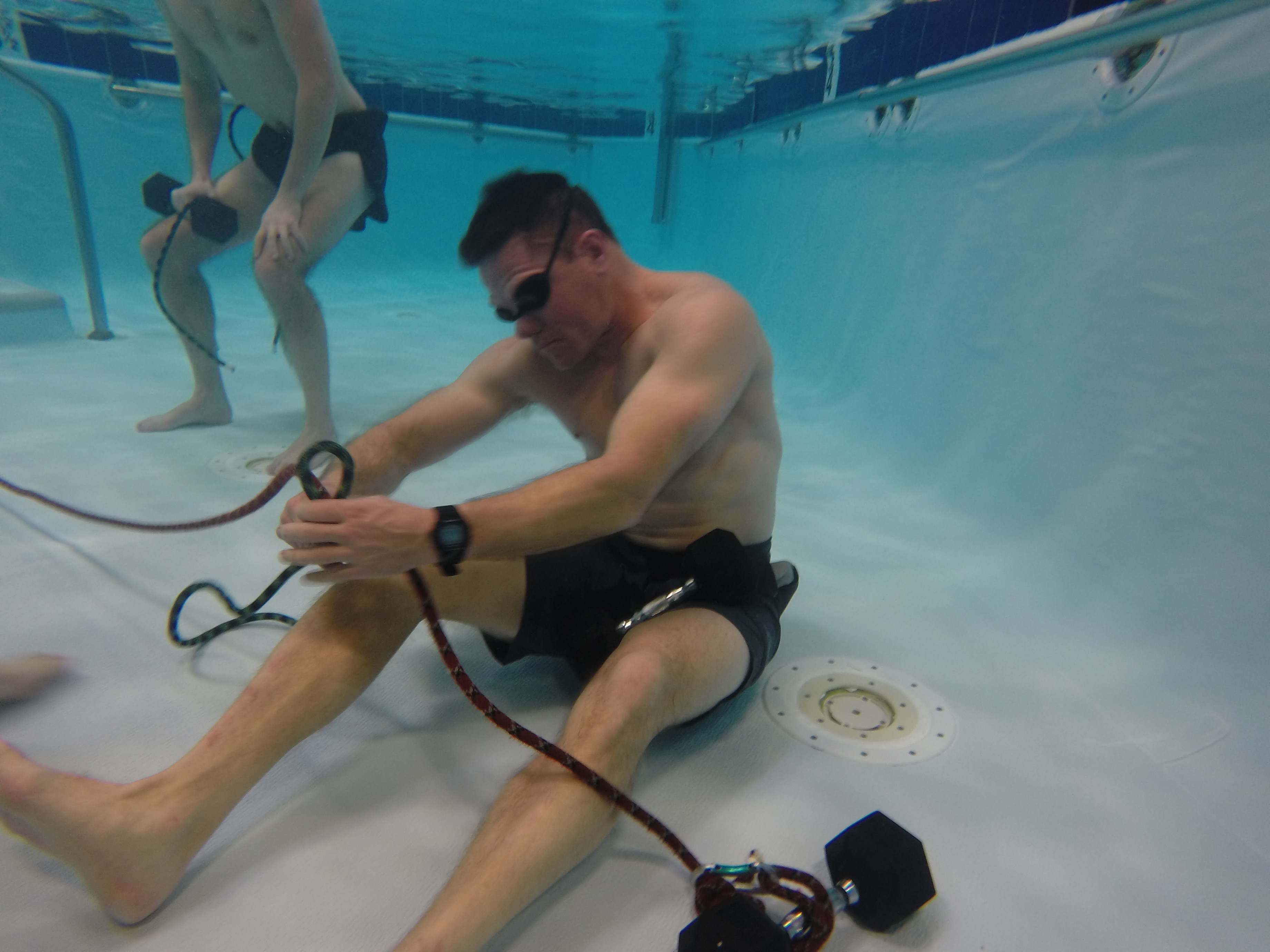
By Rob Shaul
Abstract: MTI executed an initial experiment to test mental fitness and mental composure while under stress, in a controlled, yet foreign environment. The intent was to test whether military-esque underwater composure training is applicable to mountain athletes, in regards to keeping calm and composed in stressful situations in the mountains.
The training was facilitated by Todd Wilhite, retired SOF member who has trained numerous military members in underwater confidence and preparedness for the Special Operations Combat Diver Qualification Course. The initial experiment was conducted over two days (one-hour sessions each) in a recreational swimming pool in Jackson, Wyoming. Test subjects were four (4) professional freeskiers and one (1) big mountain snowboarder. Subjects underwent a progression of breath holds underwater, including holding breath while doing set tasks underwater such as knot tying and nut and bolt combinations.
Results: At the end of the training experiment, all five mountain athletes tested were able to complete all of the specified tasks without panic.
Conclusions: The initial experiment validated that professional mountain athletes could learn to recognize and train to potentially control the instinctive responses of fight or flight to avoid panic, however, the transferability and applicability to their sport are undetermined.
Introduction: The practice of utilizing water as a training tool has proven invaluable to the military selection processes, mission success, individual survivability, and preparation for advanced scuba training.
Called “water confidence” in military circles, this is used to:
- Train safe and competent divers to conduct high-risk waterborne operations
- To engrain composure skills and competencies that are necessary and applicable to the operational hazards of a real-world situation with high levels of risk or stress (physical and mental).
Mountain Athlete’s intent was to test the applicability of water confidence training with professional big mountain freeskiers and snowboarders who regularly encounter intense, high-risk scenarios or stressful situations while training or competing in technical and no-fall terrain. Hazards include extreme exposure to deadly consequences of a fall and avalanche issues.
Questions:
- Can we replicate a fight or flight scenario in a controlled environment (water) that professional mountain athletes could experience, learn to recognize and control?
- If so, are these composure skills transferable to the mountain and applicable to hazards of their sport(s) and activities?

Experiment Specifics
Study Population: Five professional freeskiers and snowboarders who live Jackson, Wyoming and train Mountain Athlete.
- Matt Annetts (age 35, professional snowboarder)
- Sam Schwartz (age 19, professional freeskier)
- Forrest Jillson (age 28, professional freeskier)
- Morgan McGlashon (age 19, professional freeskier)
- Tess Wood (age 24, professional freeskier)
Pre-Test: This experiment and testing protocol were new to Mountain Athlete. Therefore, before testing the athletes in the study population, the format, progression, and program were pre-tested by Rob Shaul (owner/founder of Mountain Athlete) and Mike Wolfe (professional ultrarunner and Global Athlete for The North Face). Instructor Todd Wilhite put Shaul and Wolfe through a modified version of the military prescribed water confidence progression he used with his soldiers to ensure experiment intent and scope would be achieved.
The modification was as follows:
- Execute all events in 3.5 feet of water as mountain athletes are not required to be strong swimmers.
- Eliminated scuba specific events that were not applicable to the mountains.
- Scope and duration of the training evolution were executed in two (2) one-hour progressive training sessions, conducted in a calm and orderly manner with set intervals (underwater time balanced with rest time above water).
- This was training, not a selection process or mandatory gate for the athletes.
- Maximum underwater breath hold was limited to 60 seconds.
All testing was recorded with photo and video documentation during rehearsal testing, testing of the study population, and pre and post-experiment interviews were recorded with all of the athletes, the instructor, and Rob Shaul.

Athlete Testing
Results: Prior to the experiment, all athletes had and continue to compete at the professional level in their respective sports and are assessed as having high levels of strength, endurance, stamina with three years of sport specific training at Mountain Athlete. Two athletes were categorized as strong swimmers during the warm up session and all others were categorized as novice swimmers. Utilizing the composure and recovery techniques shared with the athletes by the instructor, all of the athlete were able to successfully complete all of the subsurface tasks throughout the progressive training evolutions.
Prior to experiencing the water confidence drills, the athletes were instructed on the composure and recovery techniques they can deploy to recognize and control the fight or flight instinct and panic caused by extended breath holds underwater:
Composure and Recovery Techniques
- Fight or Flight will happen. Expect it, recognize it, embrace it and manage it.
- Long exhales (mouth) coupled with deep inhales (nose) will increase recovery and help vanquish panic.
- Focus on the task. Slow down- slow is smooth, smooth is fast.
- Take a mental breath by having confidence in yourself, your training and experience.
All athletes commented that they were more apprehensive about the training on day one than they were on the second day of training and credited it to their experience and successes on the first day. Instructor’s reinforcement of the composure techniques one day one helped athletes begin to self-regulate from being unaware/untrained to a more aware/ trained athlete of techniques to mitigate stressful situations. This training proved beneficial to the athletes but it is undetermined if it is transferable or a proven solution to our initial question.
Discussion
Athlete Feedback: All of the athletes were interviewed after each training day to gather feedback of applicability, benefits, or transferability of this type of training. The following trends were reported:
- Composure techniques would be beneficial to mitigate pre-competition stress, prior to a potentially high-risk event or reacting or recovering from a (post) traumatic or high-stress event.
- Composure techniques helped athletes learn how to push their capabilities on breath-holds.
- Stress was perceived as less when athletes had a task to focus on while stress was induced or increased.
- Undetermined if this training would benefit a sudden stressful event like a fall or avalanche.
- Athletes reported as having a calming and relaxed state subsequent the training and proud of their performance. A positive experience and increased confidence in themselves.
Instructor Feedback: Todd Wilhite was initially apprehensive of implementing water confidence training on non-soldiers.
- In his past experience, candidates with high levels of “land-based” fitness (mental and physical) had the greatest potential of success however, this was not guaranteed because of the unknowns of those the attributes in response to the stresses to operating in and underwater.
- Great training is safe, relevant and realistic. Progressive training is driven by success and a desire to meet the training objectives not to make training difficult.
- Changing the standards of the event (3.5 feet) or eliminating scuba specific events did not affect the objectives or desired effects of the training.
- The water is a great training tool, it is objective, constant, and does not discriminate.
Although it is undetermined if this training would be transferable to the risks and stress of the mountains, the training did present the possibilities that water as a training tool for learning to recognize, embrace and manage stress maybe be beneficial to more than just water-related stresses. The training of professional mountain athletes validated the instructor’s theory on fitness (physical and mental), its positive effects on the outcomes of challenging real-world situations and learning
Thoughts
We have used competition, physical and other types of stress in our mental fitness training on the mountainside and pushed the envelope even further with military athletes in our work training accurate marksmanship under stress through our Range Fitness programming. However, none of these techniques can elicit the primal survival instinct of water confidence training. Eliciting this primal sense of panic is what makes water confidence training a potent and valuable tool for training composure.
We saw dramatic and rapid improvements in skill performance and underwater composure amongst the test athletes, including myself, from Day 1 to Day 2. However, what we don’t know conclusively is if the athletes were able to progress on the second day of training because of improved composure skills, or because they were simply familiar with the drills or events and knew what to expect.
Assuming the training did improve composure skills, the next question is if these skills are transferable from the controlled environment of the wading pool to the real-world, dynamic environment of mountain sports and activities. Training that is not transferable to the mountain or battlefield/streets for our tactical athletes, isn’t of much use.
The military has used water confidence training effectively for scuba instruction. Key to this transferability is the skills completed during breath holds use scuba specific equipment and tasks. We didn’t deploy sport-specific equipment or tasks with our skiers in this testing.
We plan to continue to explore water confidence training, but for the next evolution of training we will likely use climbers and mountain guides as test subjects and climbing specific equipment and tasks underwater. By doing this, we can more easily test and measure already known mountaineering specific task and competencies on land to evaluate non-stressed capabilities for time and accuracy to compare against the same tasks “stressed” when executed underwater. This will potentially eliminate the question of improvements from task familiarization versus composure technique applications.
If we can determine that this a transferable skill to the mountains, the next question will be the periodicity and frequency of training to remain proficient. i.e. is this training perishable? If so, how often should we train it?
Thinking more broadly, if water confidence can train composure under stress, and this training is transferable to other “modes” – we can explore using this methodology for a broad range of athletes – firefighters, LE athletes, motorsports athletes, medical personnel, etc. The application could be broad and exciting.
Overall, the initial training was a great opportunity to explore my original question and although we cannot determine the transferability, the training had benefits of continued exploration, learning and growth potential for our athletes.

Conclusions, Hypothesis, Next Steps
Ultimately, the hypothesis that water confidence training is transferable to mountain sports was undetermined. The consensus of Rob Shaul, Mike Wolfe and Todd Wilhite was to further analyze the training, explore new ideas to improve upon the events to make more mountain sports specific, and track the test subjects through this year’s competition and training season for feedback on the training and it application, correlation to their performance, actions, or reaction to high risk and/or stressful events for anecdotal evidence.
See clip below for training highlights.
You Might Also Like Rock Climbing Exposure Mini Study: How Can We Measure Fear?
STAY UPDATED
Sign-up for our BETA newsletter. Training tips, research updates, videos and articles - and we’ll never sell your info.
